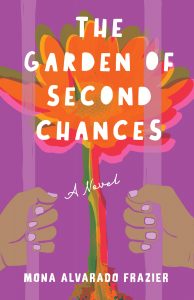The inspiration behind The Garden of Second Chances by Mona Alvarado Frazier
The inspiration behind The Garden of Second Chances by Mona Alvarado Frazier
“Behind every incarcerated girl or woman, there is a story of trauma, abuse, or neglect that needs to be told.”
 A photo from early in my career, the 1980s, shows my caseload of teenage girls incarcerated in a youth correctional facility. I’m twenty-two years old and still smiling, fresh into my job as a Youth Counselor. The girls appear thrilled to have their picture taken.
A photo from early in my career, the 1980s, shows my caseload of teenage girls incarcerated in a youth correctional facility. I’m twenty-two years old and still smiling, fresh into my job as a Youth Counselor. The girls appear thrilled to have their picture taken.
For young women under the age of twenty-one, this prison was the only one in California, leaving them isolated from their support systems, if they had any. Six bright, cheerful faces belied the traumas they experienced before ending up in confinement. What connected them was past unresolved pain from physical, sexual, or emotional abuse.
The photo is a compelling reminder of their complex and challenging lives. Half had addictions, a couple had been in gangs, and another had a minor history of runaway and petty theft. Their stories and hundreds of others stuck with me throughout my twenty-eight-year career.
I write about incarcerated girls’ lives, backgrounds, and crimes in The Garden of Second Chances. The story is set in 2003 and follows the life of Juana Maria Ivanov, the protagonist who experiences intimate partner violence (IPV) and is imprisoned for her husband’s death—a crime she denies committing. Through Juana’s story and those of the other characters, I delve into the complexities of IPV and show how incarceration compounds this pain.
The main character, Juana, is subjected to what we historically called ‘domestic violence,’ but is also referred to as IPV. This impacts over 60% of incarcerated females and 12% of American high school girls. IPV leaves people feeling isolated, humiliated, or ashamed to confide in anyone.
Incarcerated youth are disproportionately likely to have experienced trauma, abuse, or neglect before incarceration, which increases their risk of depression, anxiety, and suicidal ideation. Stigma and shame surrounding mental health issues often prevent incarcerated youth from seeking help or trusting adults.
Due to sentencing changes and policies, law and order were the slogans of the late 1980s and into the ’90s. The facility swelled with youth. My small group caseload grew to ten and sometimes twelve young women. Eight out of ten had substance addictions, and most had experienced violence.
The girls had multiple problems, and the counseling staff was stretched thin. There was too much to do and less time to give counseling. Counseling groups were too large, and individualized time with a girl was reduced. Staff hired to counsel also supervised youth in their daily activities.
Despite these dismal odds, many girls who experienced trauma and addictions tried to improve their lives. Their persistence and resilience struck me. Similarly, I recognized that the ones who gave up didn’t do so because they didn’t care, but the pain of dealing with the damage was too great to overcome without ongoing psychological treatment.
Psychological care was hard to come by in a correctional facility. The problem was the considerable number of incarcerated people who needed mental health counseling and supportive services for an extended period. In a facility with 300 girls, there were five psychologists. The increase in incarceration created a situation where limited institutional resources were stretched beyond what they could handle.
In the novel, I wrote about one girl who encounters these obstacles because I wanted to offer hope and empowerment to young women impacted by intimate partner violence. Seeing themselves reflected in fiction can be a powerful experience that lets them feel seen and understood. By creating characters who have experienced intimate partner violence and gone on to thrive, readers might see others in a new light and, I hope, instill a sense of connection and empathy.
Behind every incarcerated girl or woman is a story of trauma, abuse, or neglect that needs to be told. The Garden of Second Chances deals with complex topics like intimate partner violence and can be challenging to read. My objective is to help young women find the strength and courage to believe in themselves and their ability to create positive change in their lives.
What can we do to help? Communities can support young people who have experienced trauma and abuse through school awareness programs about IPV. We can seek increased funding for mental health services, advocate for more trauma-informed approaches to juvenile justice, and implement community-based programs that provide support and resources to families and youth.
To prevent intimate partner violence, we must understand and address the factors that put people at risk and protect them from violence. Teaching healthy, respectful, and nonviolent relationships is essential to reduce IPV.
Source: Andersson, V. et. al. (updated, 2023) “Domestic Violence [Statistics and Facts]” https://bedbible.com/domestic-
—
After decades of working with incarcerated youth and raising three creative kids as a single parent, Mona Alvarado Frazier is now fulfilling her passions of writing and traveling. When not doing either of those she’s reading, volunteering, watching K-dramas, and tending the family’s two cats and her succulent gardens. Mona’s short stories are published in the University of Nevada, Reno anthology Basta! Latinas Against Gender Violence and Palabritas, a Harvard literary journal. She is a member of SCBWI and Macondo Writers and a cofounder of LatinxPitch, a Twitter event. She is a 2021 Mentee of Las Musas Latinx children’s literature collective, and resides in Oxnard, California.
Find out more about her on her website https://alvaradofrazier.com/
THE GARDEN OF SECOND CHANCES
 Juana, a seventeen-year-old mother, is sentenced to prison for murdering her husband. She claims she’s innocent—but no one believes her, including the prison staff and a gang leader in her block who torments her.
Juana, a seventeen-year-old mother, is sentenced to prison for murdering her husband. She claims she’s innocent—but no one believes her, including the prison staff and a gang leader in her block who torments her.
Juana’s troubles aren’t confined to prison, however—she’s undocumented, and her husband’s bereaved family is now threatening to take her baby from her forever. Feeling hemmed in on all sides and desperate to stay out of trouble, Juana creates her own refuge in the prison yard: a garden she created. As she digs in the soil, nurturing the plants, she remembers her courageous, long-deceased mother, who she knows would never give in or give up. Juana’s only hope for saving herself and her baby is to prove her innocence—but how? (TW: intimate partner violence, suicide, depression)
“Frazier masterfully limns Juana’s waning hope as she comes to terms with the fact the government that’s locked her away will likely kick her out of the country after she’s released…a persistently tense story… both narratively and emotionally satisfying.” —
Category: On Writing

























